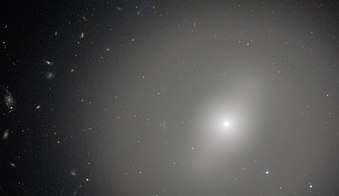NGC 1533
NGC 1533 is a barred lenticular galaxy with faint spiral structure in the constellation Dorado. The seventh-brightest member of the Dorado Group and 1°[3] off the group's center,[2] it is surrounded by a vast arc or ring of H I which is connected to IC 2038 and IC 2039.[2] The ring orbits around 32 kpc from the center.[3][b] As is typical of lenticular galaxies, star formation is weak in NGC 1533.[2] Using both the surface brightness fluctuation (SBF) and globular cluster luminosity function (GCLF) methods, its distance was estimated in 2007 to be 19.4 ± 1.1 Mpc and 18.6 ± 2.0 Mpc respectively.[2] Averaging these together gives a distance of around 19 million parsecs or 62 million light-years from earth.[a] In 1970, a supernova was detected in NGC 1533.[4]
| NGC 1533 | |
|---|---|
 | |
| Observation data (J2000 epoch) | |
| Constellation | Dorado |
| Right ascension | 04h 09m 51.8s[1] |
| Declination | −56° 07′ 06″[1] |
| Redshift | 790 ± 5 km/s[1] |
| Distance | 62 ± 4 Mly (19.0 ± 1.1 Mpc)[2][a] |
| Apparent magnitude (V) | 11.7[1] |
| Characteristics | |
| Type | (L)SB(rs)00[1] |
| Apparent size (V) | 2′.8 × 2′.3[1] |
| Other designations | |
| PGC 14582[1] | |
NGC 1533 was discovered by John Herschel on December 5, 1834.
Notes
References
- "NASA/IPAC Extragalactic Database". Results for NGC 1533. Retrieved 2008-06-26.
- DeGraaff, Regina Barber; Blakeslee, John P.; Meurer, Gerhardt R.; Putman, Mary E. (December 2007). "A Galaxy in Transition: Structure, Globular Clusters, and Distance of the Star-Forming S0 Galaxy NGC 1533 in Dorado". The Astrophysical Journal. 671 (2): 1624–1639. arXiv:0710.0893. Bibcode:2007ApJ...671.1624D. doi:10.1086/523640.
- Ryan-Weber, Emma; Webster, Rachel; Bekki, Kenji (April 2003). Jessica L. Rosenberg; Mary E. Putman (eds.). Galactic Recycling: The HI Ring Around NGC 1533. The IGM/Galaxy Connection: The Distribution of Baryons at Z=0, ASSL Conference Proceedings. 281. Dordrecht: Kluwer Academic Publishers. p. 223. arXiv:astro-ph/0209321. Bibcode:2003ASSL..281..223R. doi:10.1007/978-94-010-0115-1_40. ISBN 978-1-4020-1289-1.
- Evans, R. (1970). "Supernova in NGC 1533". IAU Circ. 2279 (2279): 1. Bibcode:1970IAUC.2279....1E.
External links
| Wikimedia Commons has media related to NGC 1533. |
- NGC 1533 on WikiSky: DSS2, SDSS, GALEX, IRAS, Hydrogen α, X-Ray, Astrophoto, Sky Map, Articles and images
- Sky View image of NGC 1533